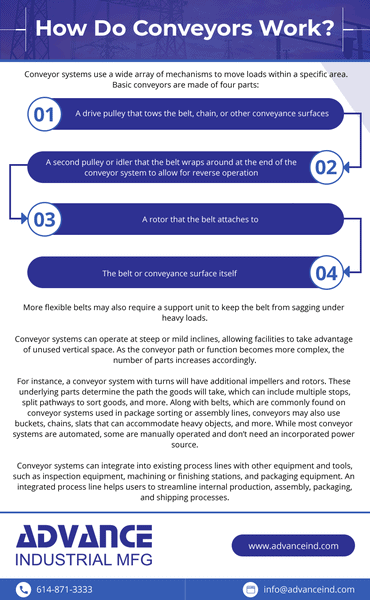A conveyor is a mechanized material handling system. For example, conveyor belt systems—one of the most popular conveyor system types—feature a rolling belt that can move goods along a predetermined route. Conveyance systems are automated and can manage the movement of heavy, bulky, and high-volume goods to different stations or stops along a production, testing, or sorting process.
By transporting goods without requiring manual carrying, conveyance systems reduce workplace industries, decrease labor-related costs, and allow for more complex sorting and movement with increased accuracy. This blog post will discuss how conveyor systems work, the different types available, and how Advance Industrial Manufacturing can create the right conveyor system for your facility.
How Do Conveyors Work?
Conveyor systems use a wide array of mechanisms to move loads within a specific area. Basic conveyors are made of four parts:
- A drive pulley that tows the belt, chain, or other conveyance surfaces
- A second pulley or idler that the belt wraps around at the end of the conveyor system to allow for reverse operation
- A rotor that the belt attaches to
- The belt or conveyance surface itself
More flexible belts may also require a support unit to keep the belt from sagging under heavy loads.
Conveyor systems can operate at steep or mild inclines, allowing facilities to take advantage of unused vertical space. As the conveyor path or function becomes more complex, the number of parts increases accordingly.
For instance, a conveyor system with turns will have additional impellers and rotors. These underlying parts determine the path the goods will take, which can include multiple stops, split pathways to sort goods, and more. Along with belts, which are commonly found on conveyor systems used in package sorting or assembly lines, conveyors may also use buckets, chains, slats that can accommodate heavy objects, and more. While most conveyor systems are automated, some are manually operated and don’t need an incorporated power source.
Conveyor systems can integrate into existing process lines with other equipment and tools, such as inspection equipment, machining or finishing stations, and packaging equipment. An integrated process line helps users to streamline internal production, assembly, packaging, and shipping processes.
Different Types of Conveyor Systems
There are many types of conveyor systems available for commercial and industrial applications, making it essential to choose the right type for the specific needs of your facility and business. Some of the distinct types of conveyor systems include:
- Aero-mechanical conveyors
- Automotive conveyors
- Belt conveyors
- Belt-driven live roller conveyors
- Bucket conveyors
- Chain conveyors
- Chain-driven live roller conveyors
- Drag conveyors
- Dust-proof conveyors
- Electric track vehicle systems
- Flexible conveyors
- Gravity conveyors
- Gravity skate wheel conveyors
- Line-shaft roller conveyors
- Motorized-drive roller conveyors
- Overhead I-beam conveyors
- Overland conveyors
- Pharmaceutical conveyors
- Plastic belt conveyors
- Pneumatic conveyors
- Screw or auger conveyors
- Spiral conveyors
- Vertical conveyors
- Vibrating conveyors
- Wire mesh conveyors
To maintain operational efficiency, look for systems that can handle the weight, shape, and materials of the materials and goods you typically move. Other factors to consider in the selection process may include energy efficiency, size constraints, safety, and potential future modifications to accommodate growth.
Custom Conveyor System Manufactured by Advance Industrial MFG
At Advance Industrial Manufacturing, we specialize in creating custom solutions for our clients. We have extensive experience in creating custom conveyor systems that help our customers improve throughput. To see how our metal fabrication and machining capabilities can benefit your operation, please contact us or request a quote today.

